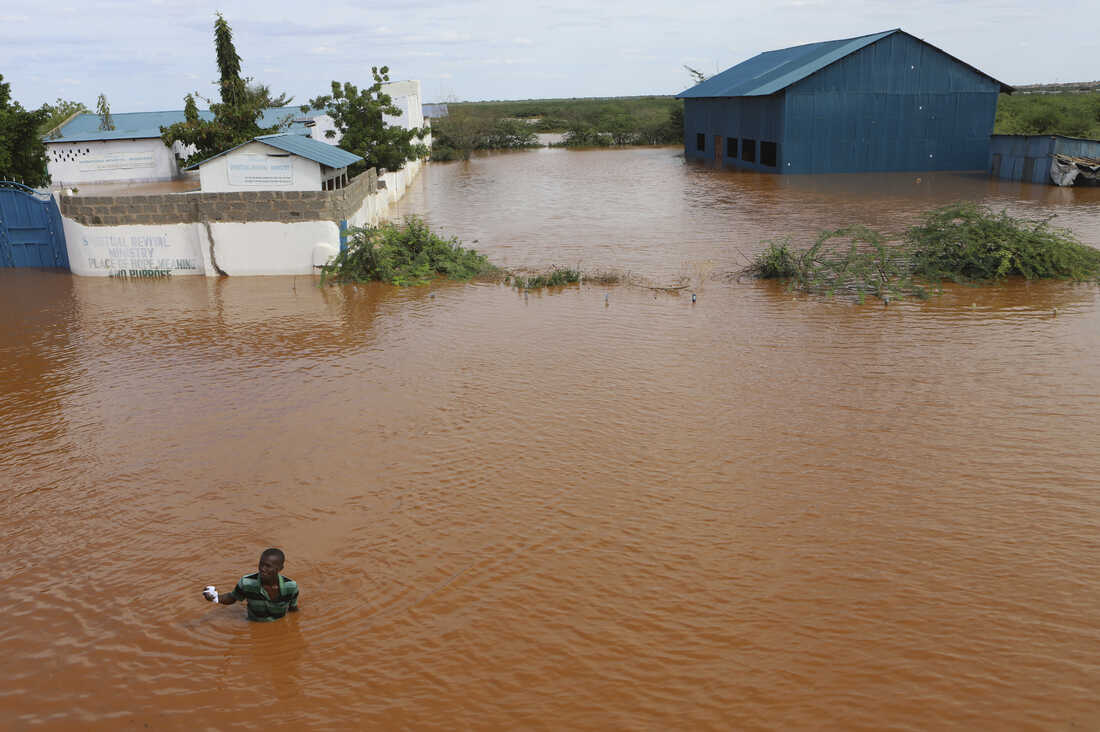Africa
As Kenya’s flood toll rises, Human Rights Watch says officials must step up efforts
A man swims from a submerged church compound, after the River Tana broke its banks following heavy rains at Mororo, border of Tana River and Garissa counties, northeastern Kenya, April 28. Heavy rains pounding different parts of Kenya have led to dozens of deaths and the displacement of tens of thousands of people, according to the United Nations.
Andre Kasuku/AP
hide caption
toggle caption
Andre Kasuku/AP
A man swims from a submerged church compound, after the River Tana broke its banks following heavy rains at Mororo, border of Tana River and Garissa counties, northeastern Kenya, April 28. Heavy rains pounding different parts of Kenya have led to dozens of deaths and the displacement of tens of thousands of people, according to the United Nations.
Andre Kasuku/AP
NAIROBI, Kenya (AP) — Human Rights Watch accused Kenyan authorities on Thursday of not responding adequately to ongoing floods that have killed more than 170 people since the start of the rainy season.
The New York-based rights group said the government “has a human rights obligation to prevent foreseeable harm from climate change and extreme weather events and to protect people when a disaster strikes.”
Kenya’s Meteorology Department sent an early warning before the rainy season started, but President William Ruto only formed a response committee on April 24. By then, nearly 100 people had died due to the flooding.
Kenya, along with other parts of East Africa, have been overwhelmed by floods. More than 150,000 people are displaced and living in dozens of camps.
The rights group said the government did not draw lessons from the last year’s rainy season that left hundreds of people dead.
A lodge is seen in the flooded Maasai Mara National Reserve, which left dozens of tourists stranded in Narok County, Kenya, Wednesday. Kenya, along with other parts of East Africa, has been overwhelmed by flooding.
Bobby Neptune/AP
hide caption
toggle caption
Bobby Neptune/AP
A lodge is seen in the flooded Maasai Mara National Reserve, which left dozens of tourists stranded in Narok County, Kenya, Wednesday. Kenya, along with other parts of East Africa, has been overwhelmed by flooding.
Bobby Neptune/AP
The meteorology department had warned that the country would experience increased rainfall due to the El Niño until early this year, but Ruto in October said the country had been spared by the weather pattern.
The government announced at the time that at least 10 billion Kenyan shillings ($75 million) would be released to prepare a nationwide response. It is unclear how the funds were used, and critics have accused the government of misappropriation.
Children fleeing floodwaters that wreaked havoc at Mororo, border of Tana River and Garissa counties, northeastern Kenya, April 28.
Andre Kasuku/AP
hide caption
toggle caption
Andre Kasuku/AP
Children fleeing floodwaters that wreaked havoc at Mororo, border of Tana River and Garissa counties, northeastern Kenya, April 28.
Andre Kasuku/AP
Those affected by ongoing flooding in Mai Mahiu, in the west of the country, have accused the government of a slow response. At least 45 people died after a river overflowed and destroyed houses, with more than 80 people missing since Monday. The debris has not yet been cleared to recover any buried bodies.
On Tuesday, the government directed those living in flood-prone areas to move or be evacuated forcefully, as more rain is predicted across the country through May.
A man walks through floodwaters in Kisumu, Kenya, April 17.
Brian Ongoro/AP
hide caption
toggle caption
Brian Ongoro/AP
A man walks through floodwaters in Kisumu, Kenya, April 17.
Brian Ongoro/AP
